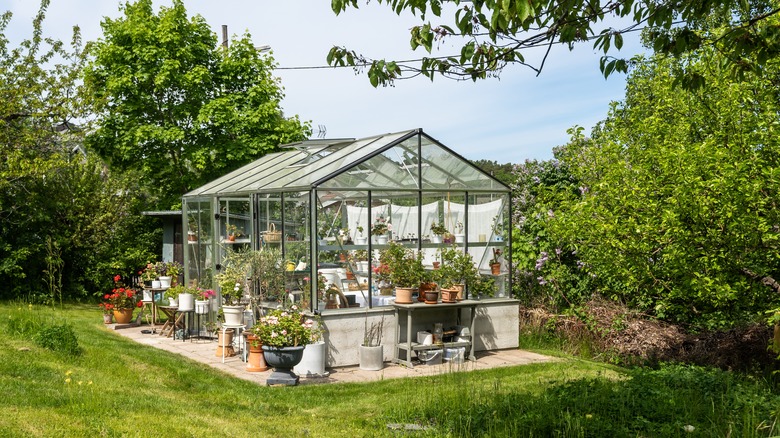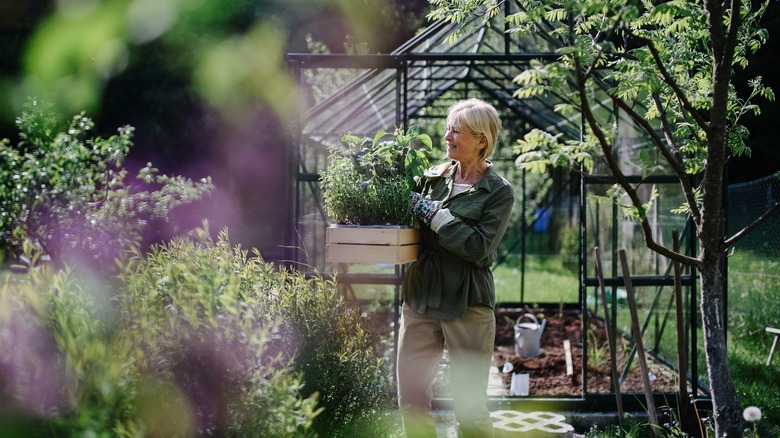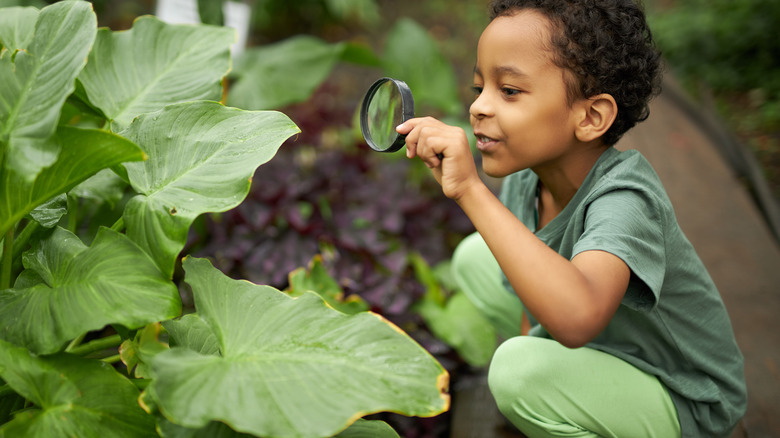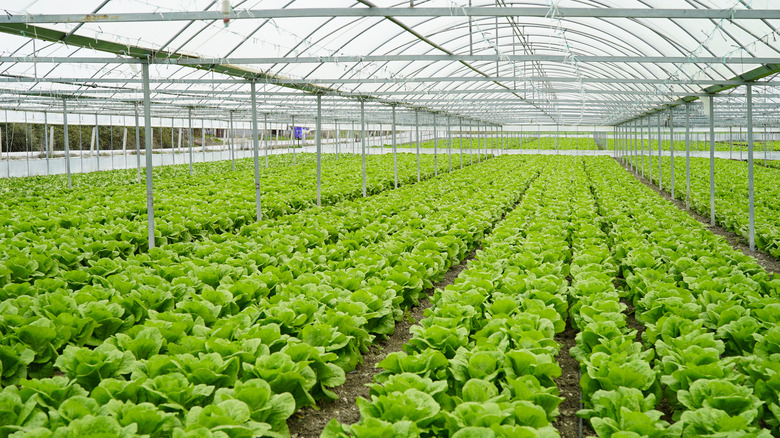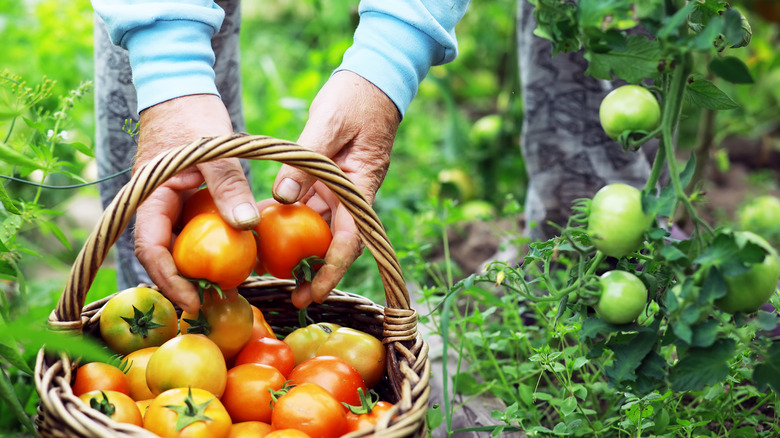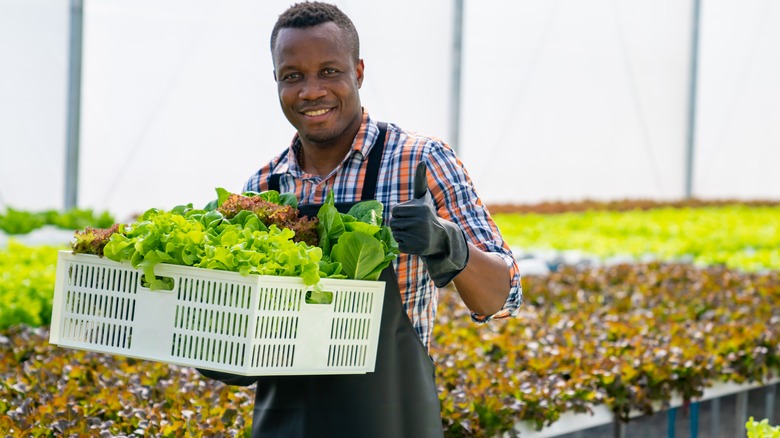How Much Does It Cost To Build A Greenhouse From Scratch
Greenhouses are a critical addition to the yards of homeowners that love growing their own fruits, vegetables, and herbs. In northern climates, a greenhouse is an essential part of the cultivation process because the extended duration of cold on either end of the primary growing season increases the need to plant indoors for a full harvest.
Forbes Advisor reports that the average cost to install a newly built greenhouse on your property hovers right around $15,000 for a large, custom construction. However, it's important to note that greenhouses can range across a substantial price gap, from $2,500 to over $25,000, depending on the size, materials used, and customizations desired. Alternatively, homeowners can introduce a small, prefabricated greenhouse or use a greenhouse kit for a minimized growing space that comes with a much lower cost — typically ringing up between $1,000 and $2,000, according to Greenhouse Info.
A greenhouse can range in scale from something resembling a commercial setup to a simple installation that protects a few key plants through the winter months. But all greenhouses share a few key features that will certainly play a role in your decision to install one type over another.
Factors for cost
Because of the many different kinds of greenhouses that you might consider for your property, there are a considerable number of factors when it comes to estimating the overall cost. Regardless of the type you select, the price of a greenhouse is primarily based upon the size and required growing amenities that you'll include.
Size dictates much of the price tag
The overall size of the greenhouse that you select will dictate much of the cost. Forbes Advisor estimates that greenhouse construction runs between $25 and $35 per square foot. Therefore, perhaps the most important element in estimating your overall cost is the size that you anticipate for the finished product. The square footage of your new greenhouse balloons the price in more ways than one, though. First, a permanent installation will require pouring a concrete slab or creating some other kind of foundation upon which to build the structure. HomeGuide reports an average cost of between $4 and $8 per square foot for this addition to the project.
With greater floor space comes a higher demand for integrated services
In addition to the actual building, a greenhouse of any size requires windows, doors, ventilation, irrigation, and other integrated services that will support the plant life growing within. Angi reports that plumbing services to hook up your irrigation system (in the event that you're adding a complex installation that you can't finish on your own) typically run between $45 and $200 per hour, on top of the cost of the equipment itself. Naturally, a larger greenhouse will require more piping to support watering efforts than a small one.
Many large greenhouses make use of built-in planters or an interior garden bed setup
Another essential cost in the construction of a greenhouse is the planter space that you'll include inside the unit. Greenhouse Hunt suggests building your own beds and raised planters to reduce the overall cost, while Lawn Starter estimates the average cost for a raised bed at around $145.
Typically, homeowners that are installing a permanent greenhouse will opt to include interior fixtures rather than simple nursery pots (ranging in size, of course) that will rest on the floor. For a small, prefabricated greenhouse that doesn't take up much space in the yard, this might be the best approach. However, in a larger greenhouse renovation, going all-in on the addition is often the best approach — and this means that you'll want to spring for dedicated planters, preparation tables, shelving, and other purpose-designed interior elements.
Additional costs
In addition to the more obvious costs associated with this construction project, there are some other features that are essential to a successful greenhouse installation, which can raise the overall price of the project.
Laying a foundation is critical for larger greenhouse installations
As mentioned previously, building a permanent greenhouse requires the use of a foundation. This means digging out a section of the yard, leveling it off, and making use of concrete mix and rebar to provide stability and structure. Many homeowners opt to tackle smaller foundation pouring operations on their own. HomeAdvisor estimates that 40% to 60% of the overall cost of a new foundation lies in the labor, so eliminating this expense can really save you a lot of money when approaching a smaller job that can potentially be managed without the help of a professional.
However, it's important to note that the foundation acts as a support system for the entire project. Therefore, it's a good idea to ensure that you know exactly what you're doing before engaging in this project on your own.
Ventilation and shading play a role in the health of your protected plant life
It might seem counterintuitive initially to add ventilation or shading elements to a greenhouse, but the truth is that plants can easily overheat in this environment, making these additions essential for your climate control needs. The Royal Horticultural Society reports that plants grown in greenhouse environments (those making use of polycarbonate column glass and other framing materials to help seal off an indoor growing environment from the outdoor climate) require shading and ventilation during the summer months, in particular.
Garden & Greenhouse suggests that ventilation is crucial for both humidity and temperature control, but also helps with air circulation that provides plants with clean, healthy air, and the natural wind effect that they need to grow effectively. Fixr estimates that the average cost of a home ventilation system is $400, with roof exhaust fan installation (that more closely mirrors the fan layout that might be used in a greenhouse) costing around $120.
As well as air circulation, protection from the most intense sunlight is critical for a grower looking to prevent burning or excessive evaporation that leaves plants trying to grow in too arid an environment (via University of Massachusetts Amherst Extension).
Lighting and heating additions add to the bottom line
Depending on the type of plants you're growing, additional lighting and heating elements may be required to support the needs of your crop. Greenhouse Emporium reports that plants can be coaxed into more efficient growth with the help of particular light wavelengths, specifically red and blue light. Adding bulbs or other specialized growing lamps that can be used when needed and deactivated when not can take your greenhouse to the next level. These are particularly good for homeowners who want to make use of their greenhouse to support all-season growing, even in the most intense winter cold.
Just like lighting additions, heat mats and other passive or active heating elements can make the difference between a greenhouse that supports thriving growth during the cold months or one that simply allows you to protect crops in their dormancy. Depending on your location, the installation of dedicated heat sources may be a requirement, or it may simply act as a balm that helps you reliably extend the growing season.
The plants themselves can add up
Lastly, the plants that you'll be growing in the greenhouse add to the final cost. Homeowners looking to build a flower garden often expect a fairly minimal budget, with a huge variety of options to choose from (via Gardening Etc). Likewise, gardeners thinking of adding fruits and vegetables to the planning space of the greenhouse can often find deals on great seeds. However, bare-root plants, trees, and other established plants will often come at a premium.
Additionally, small trees sourced from the nursery can often run you around $100 per tree, according to Angi. Smaller trees are a great addition to larger greenhouses because they can provide an abundance of fruits or nuts for the family. But trees and larger bushes come at a cost.
Types of greenhouses
You'll also need to think about the type of greenhouse that best suits your yard space. Homeowners typically utilize one of three main greenhouse setups. The Texas A&M University Extension reports that these three primary designs — the lean-to, detached greenhouse, and ridge and furrow structure — dominate the market.
Lean-to
The lean-to design is often the most popular for homeowners and hobbyist growers. Gothic Arch Greenhouses reports that a lean-to construction is one that makes use of an existing exterior wall and is placed up against the home or any other structure. They are typically comprised of a high wall that rests against the home and a lower side facing outward to capture full sunlight throughout the day. These structures come in a variety of sizes and shape configurations and a custom build can give you access to any kind of structure that suits your home.
Detached
The main difference between a lean-to and a detached greenhouse lies in where the structure will be placed. A lean-to sits against an existing wall, whereas a detached greenhouse stands apart from your home or any other building on the property (via Build With Rise). A detached greenhouse is a fantastic option for homeowners with expansive yard space and a dedication to long-term cultivation. These greenhouses look great and they serve their purpose admirably.
Ridge and furrow
These greenhouses are most often seen in commercial growing operations; however, an understanding of their layout can help a homeowner looking for a large, customized installation. These make use of heavier outer wall materials and are constructed as an interconnected series of open interior spaces without walls. Essentially, a ridge and furrow greenhouse provides effective rainwater drainage from above while ensuring that the interior space can make use of efficient ventilation and sunlight coverage.
Why you might need a greenhouse
Greenhouses offer themselves as a great beautification element to your property, but they also provide a variety of excellent additions to your lifestyle and property's value on top of the shift in aesthetics.
Greenhouses and garden spaces can add to the property value
Planted Shack estimates that gardens and greenhouses can raise your property value by as much as 5%. This is great news for homeowners looking to enhance their garden while also bringing a new addition to the property that will eventually pay financial dividends as well. Realty Times reports that a greenhouse can add to the aesthetic look of a property on the market, and interested buyers often flock to homes that include these types of unique amenities.
However, It's important to remember that shoddy workmanship can actually detract from the financial value of the home and its exterior landscape (via House Affection). Therefore, any homeowner looking to add this feature to their outdoor space will want to ensure a high-quality build that lasts for many years and won't become a liability in the future.
Using a greenhouse can transform the way you do your weekly shopping
The addition of a greenhouse can also change the way you think about shopping for groceries. An avid gardener can cultivate a significant vegetable or fruit selection, augmenting the kitchen and pantry in a meaningful way. What's more, homegrown fruits and vegetables often taste far superior to those bought in the store. Mitchell's Nursery & Greenhouse reports that store-bought fruits and vegetables are harvested before they reach peak ripeness, and the time it takes to move produce from the field to the shelf can have a dramatic impact on the chemical and biological makeup of its sugars and other compounds.
The calmness of agriculture offers a slowdown to the rapid pace of modern life
Lastly, many homeowners are making a turn toward self-sufficiency and the peace and tranquility that a garden can provide as a result of the hectic world that surrounds the average consumer these days. Agriculture provides an intense calm, and this is perhaps why so many people are engaging in gardening in the modern world, with garden-specific spending increasing by 77% from April to June of 2021, according to Country Living.
Benefits of a greenhouse for avid growers
Adding a greenhouse to your home can provide a wealth of benefits. The relaxation that you can take from spending time in the garden is immense, and the functional value that this provides to your ability to cultivate the types of plants that feed into your happiness is even greater.
A greenhouse extends the functional growing season and can even provide for year-round cultivation
The most obvious benefit of a greenhouse rests in your ability to plant anything you like at any time of the year (via Outdoor Living Today). The installation of a greenhouse gives you the ability to circumvent prevailing weather conditions that exist outside your home. Put bluntly, commercial agriculture today couldn't survive without the use of these facilities to guarantee a consistent supply of fruits and vegetables throughout the year. Bringing this technology to your own home allows you to defeat the weather and grow anything that you want to use in the pantry, or a plethora of otherwise-seasonal flowers that can brighten up the interior space of your home at all times.
Starting plants indoors gives your new seedlings a head start in the summer months
For growers who want to continue taking advantage of outdoor growing spaces, the installation of a greenhouse can give you a head start on the spring planting months. Peppers, tomatoes, and berries of all varieties, for instance, won't wake from dormancy (if overwintering) until around the yearly expected last frost date in your local area (listed here according to USDA zone by The Spruce).
If you're planting a new crop from seed, sowing the seeds a few weeks before the last frost date requires you to start the plants indoors. This can be a problem for those living in small or busy homes that can't support the overlapping storage and sunlight needs of newly planted seeds. Your greenhouse can solve this problem with ease.
The addition of a greenhouse can amplify your passion for growing, plant care, and the outdoor lifestyle
According to a 2019 study by White, et. al., it's been found that time spent outside in nature is linked directly to mood, health, and wellbeing (via nature.com). This connection is often reported by many different outlets, and homeowners across the country are taking notice. Adding a greenhouse to your home's footprint provides a unique addition that can help you spend more time in the presence of sunlight, plant life, and a generally relaxing environment that supports your ongoing mental and physical health.
